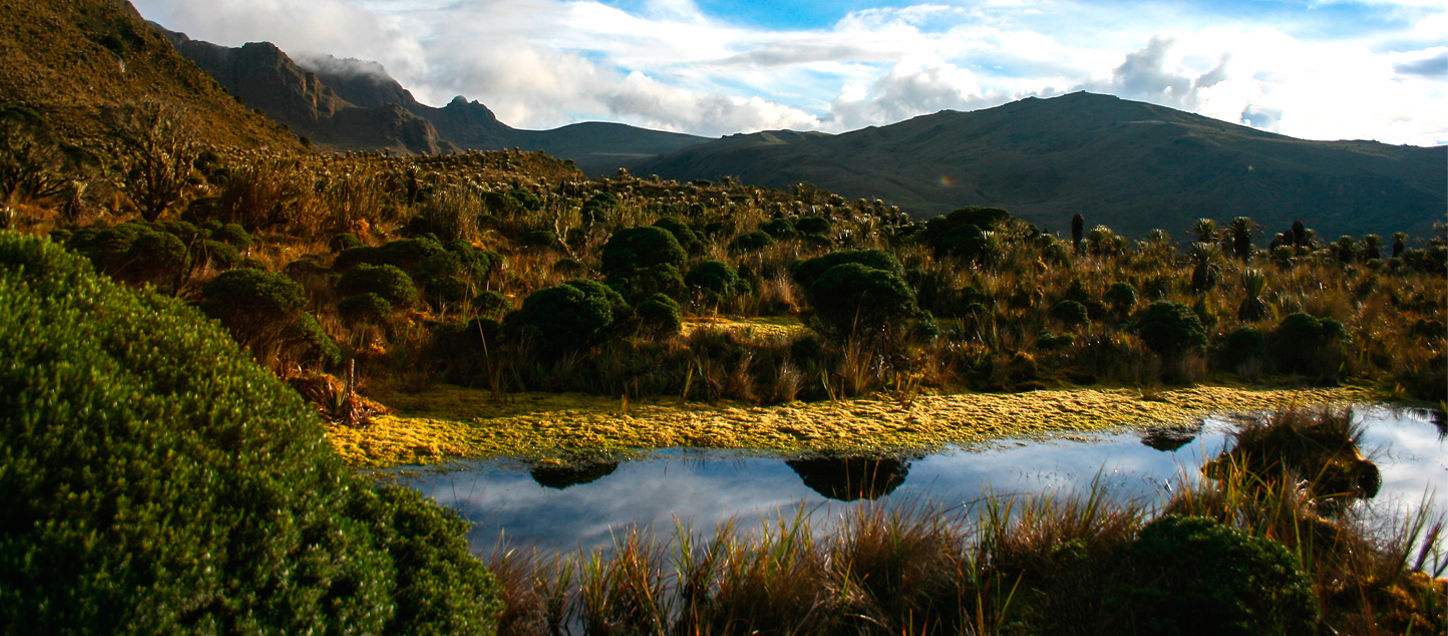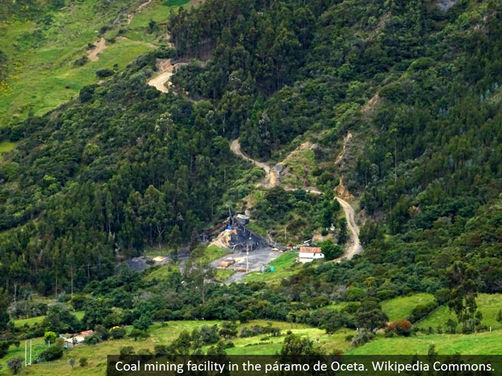

Digital
Environmental
Justice
Storytelling project
Protection of Páramos
DELIMITATION AND ITS CONTROVERSIES
_jp.jpg)
EXTRACTIVISM, ENVIRONMENTAL PROTECTION, AND GOVERNMENT INTERVENTION IN THE PÁRAMOS

Páramos represent only two percent of Colombia’s national territory, but provide water to 70 percent of its people.
Situated in the highest parts of the Andes Mountains are the rare alpine tundra ecosystems known as the páramos. There are páramos only in six countries, and between 50 and 60% of them are located in Colombia. Unfamiliar to those outside the Andes region, the páramos are an essential water source for most of the country with aquifers that feed many important rivers. Large páramos like Sumapaz, for example, provide most of the drinking water to the capital city of Bogotá. These ecosystems are inhabited by a plethora of unique flora and fauna, such as frailejones and the oso de anteojo (Spectacled Andean bear), although the paramos in total only make up about 2% of Colombia's national territory. They are also home to rural communities who have lived and earned their livelihoods from the páramos or adjacent to the páramos for decades, many as small and medium scale miners and subsistence and commercial farmers.
Social lives of Frailejones

24% of the Santurbán páramo remains unprotected as it did not receive official designation during the governmental delimitation process in 2017.
In the early 2000s, under the eight year administration of former president Álvaro Uribe, industrial mining grew exponentially in Colombia. According to Ingeominas, the government agency in charge of granting mining titles, from 2002 to 2010, mining titles expanded from covering 2.8 million acres to 21 million acres in the country. By 2011, 7% of land in the páramos was in the hands of mining companies in pursuit of coal and gold. Although small-scale mining has been a traditional practice of some paramuno communities, multinational corporations like Greystar, a Canadian company (now known as Eco Oro), have sought to acquire more mining titles and expand their open-pit mining operations. These operations would be particularly devastating for the environment in the extensive areas that must be entirely stripped of vegetation. Chemicals leached from open-pit mining could also end up contaminating the water supplies that flow throughout the country.
Images of the impacts of mining, militarization, agriculture, and landscape transformation in Colombia's páramos.

Listen to this podcast by the NGO Ambiente y Sociedad that explains the new normativity for páramos. October 21, 2020.
Concern about the impacts of industrial mining created controversy among citizens, who organized to prohibit it in the páramos. Environmental authorities responded to these demands and attempted to prohibit economic activities in these ecosystems via a delimitation process in 2011. Delimitation involved the government mapping the areas of páramos and determining what is and is not part of these strategic ecosystems. Originally, these boundaries limited all economic activities in the páramos. This meant that not just the industrial mining practices of corporations were prohibited, but also the agricultural practices and smaller scale mining of local rural communities. This universalizing response of prohibition in the name of conservation provoked major pushback from rural communities living in and near the delimited páramo areas.
These rural communities were no longer allowed to engage in any economic activity inside these newly delimited zones. Municipalities mainly composed of páramo feared economic restrictions on their citizens’ livelihoods and their ability to continue existing. Paramuno communities and those living in the buffer zones of páramos interpreted the delimitation as potentially favoring future interests to privatize important source water or to capitalize on tourism opportunities. They
view the delimitation as acting to establish which areas can be exploited by corporate/extractive actors more than what should be conserved by all. Campesino and indigenous communities pointed out the lack of broad citizen
participation and respect for prior consultation rights. They argued that conservation should not come at the cost of their livelihoods and provoke displacement, dispossession, and further land and water grabbing.
While delimitation emerged as a universal response to protect important sources of urban drinking water, in practice it caused different responses and concerns among paramuno communities that depend on local territorial dynamics and current and prospective economic activities. The state then backtracked in 2018, acknowledging the conflicts provoked by its original delimitation process, and declared the need for a more participatory process.
Anthropologist Carolina Botero gives a personal account of what she witnessed at court proceedings during debates over the
delimitation process.

This venn diagram serves as a visual representation of the overlapping socio-environmental conflicts occurring in the páramos of Colombia. The páramos exist at the crossroads of a number of different actors and interests, all of which must be integrally understood and placed in dialogue to ensure the health of these ecosystems and paramuno communities.

The páramos are shrinking: The current area of the páramo of Puracé is only 5% of what it was 20,000 years ago due to unique geological mountain building and connectivity changes.
The current socio-environmental conflicts in the páramos are socially-derived problems that are also inextricably connected to the challenges of climate change. With global warming and the potential drying of the páramos, water stored in the spongy soils could become more difficult to access. Although the climate has natural cycles of cooling and warming, the human-provoked warming of the last century is worrisome in terms of its potential to impact the availability of drinking water in these extremely important and unique ecosystems. Residents of different páramos also worry about the negative effects of deforestation, urban expansion, acid rain, and the combination of stronger winds and heavier rains in terms of creating risk zones and multiple and overlapping forms of degradation, depending on the particularities of each páramo ecosystem and the corridors that connect them.
This video, made by the Earth Institute of Columbia University in New York, explores what a warmer, drier future would mean for the unique ecosystems of the Colombian páramos. The páramos provide water for much of the country, meaning that warming in these high altitude areas would have grave and widespread consequences. Citizens and professional scientists alike in the country are now on a mission to promote conservation efforts that will slow down the warming trends of climate change.
Listen to an interview with Ricardo Perdomo, a leader of the Cruz Verde Páramo Committee and member of the Cerros Orientales of Bogotá Environmental Working Group.
Ricardo introduces both of the organizations he participates in and explains how the Reserva Forestal Protectora Bosque Oriental de Bogotá overlaps with the páramo of Cruz Verde and its connectivity with the páramo of Sumapaz. The mission of these community organizations is to maintain a dialogue with Bogotá and to take legal action when necessary in order to guarantee the permanence of communities in their territories and lands; for example, when citizens organized to prevent a subtraction of the forest reserve for urban expansion.
Ricardo explains how the Cerros Orientales organization formed in 2004 while the Committee of the Páramo of Cruz Verde organized in 2015 as a response to mining interests that began to exert pressure near the páramo. He also discusses the rights of the community to participate in public policy decisions over the use of water and soils, the design of alternatives to development, and climate change mitigation strategies that also guarantee their wellbeing.
Ricardo shares citizen observations about the impacts of climate change on the Cerros Orientales and the páramo. He also mentions their worries about continued urban expansion. He explains the acción de tutela that they organized to revoke the first páramo delimitation law and
wonders aloud about what will happen with the new participatory delimitation process. He concludes by expressing local concerns over future rights to water and potential privatization.

COLLABORATORS
RESEARCHERS

REFERENCE MATERIALS
Click here to see the reference materials used in the research for this topic.

OUR PROCESS
Learn more about our public engaged, participatory research process.

SOLIDARITY ACTIONS
Find out ways to support local efforts and community-led processes and initiatives.
Listen to a conversation with Carlos Alberto Morales, member of the Union of Agricultural Workers of Sumapaz (SINTRAPAZ).
Carlos explains how he came to participate in SINTRAPAZ, a campesino organization that is over 60 years old. He was born in the municipality of Fusagasugá, and shares how his organization understands Sumapaz as a region of municipalities.
He explains Bogotá's historical interest in water conservation and exploitation in Sumapaz and the annexation of areas of Sumapaz where campesinos lived by the capital city during the 1950s.
Carlos speaks about the first creation of a national park in the páramos in the 1960s that produced ongoing tensions between conservation agendas and campesino livelihoods.
He mentions the intensification of mining-energy activities in the 2000s that overlap with the dynamics of armed conflict and pressure to build a hydroelectric dam in la Unión, Sumapaz.
Referencing the delimitation process, Carlos mentions the first example of the páramo of Santurbán and community interpretations of delimitation as ultimately favoring extractive interests while prohibiting their livelihoods. For now, he says they do not understand what will happen with the participatory delimitation process that was ordered by the court.
While the new delimitation process does recognize campesino presence in the páramos, there are other district interests, such as the creation of a regional metropolitan area, that continue to place pressure on campesino lands and the future of Sumapaz.
See this documentary made by National Parks in Colombia about the Spectacled Andean bear (oso de anteojos) and its role as a guardian of the country's páramos.
Social Lives of Frailejones
Frailejones are tall, thick-leaved succulent-like plants endemic to the páramos. The páramos are typically dark and foggy due to their high altitudes. There is a popular story in Colombia about when Spanish colonizers first arrived, unfamiliar with the páramos, they saw the frailejones in the distance and thought they were members of an advancing army. In reaction, they are said to have retreated.


Protection of Páramos
DELIMITATION AND ITS CONTROVERSIES


















